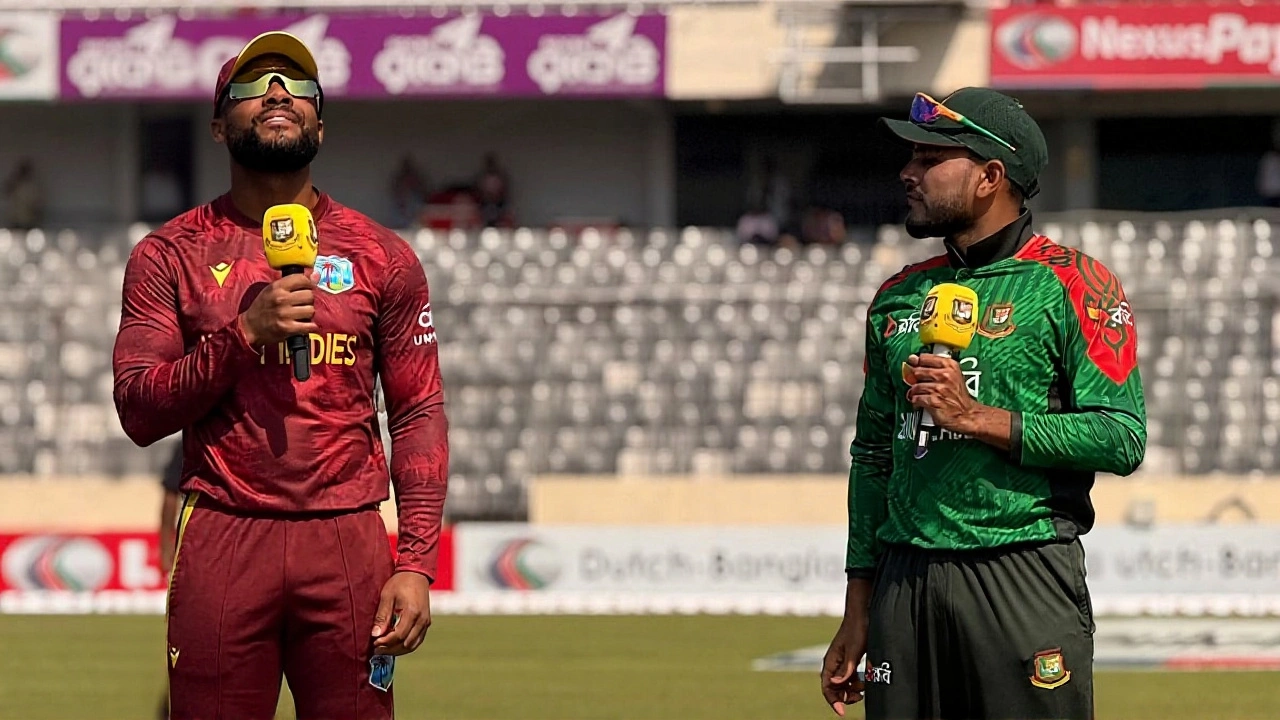When Rishad Hossain removed the first five West Indies batters in the first ODI at the Sher-e-Bangla National Cricket Stadium on October 25, 2025, even veteran commentators fell silent. Six wickets for 35 runs. A legspinner’s dream. A batsman’s nightmare. And the most deliberate pitch Bangladesh had ever laid down — not just to win a match, but to rewrite the World Cup qualification map.
The Pitch That Broke the Batting Lineup
The surface at Mirpur, Dhaka, was unlike anything seen in recent ODI cricket. Dusty, cracked, and alive from ball one, it rewarded patience and punished aggression. By the end of the first innings, West Indies were all out for 159. Bangladesh, batting second, scraped to 181 — not because they were poor, but because the ball turned sharply, gripped viciously, and kept low. Only 340 runs were scored across both innings. Eleven of the 20 wickets fell to spin. Fast bowlers? They were spectators. The pitch didn’t just favor Bangladesh’s spinners — it neutralized West Indies’ biggest strength: explosive top-order batting.
"The wicket was same for both teams," said Rishad Hossain, Player of the Match, in the post-game presser. He wasn’t just defending his performance. He was defending a strategy. "We have encountered an even worse pitch in Guyana. We adjusted to those conditions. It was the same condition for both sides." His reference to the 2022 series in the Caribbean wasn’t casual. It was a reminder: Bangladesh had been here before. They knew how to survive. West Indies, for all their power, were out of their depth.
Why This Pitch Wasn’t Just About Cricket — It Was About Survival
This wasn’t a home advantage. It was a survival tactic. According to Wisden’s report on October 18, 2025, only the top eight teams in the ICC ODI rankings as of March 31, 2027 would qualify automatically for the 2027 World Cup. South Africa and Zimbabwe — as hosts — were guaranteed spots. But Zimbabwe was ranked 10th. That meant the top nine teams would qualify. And at the time of the series, West Indies sat at ninth. Bangladesh? Tenth. One spot. One series. One chance.
The ICC’s rankings predictor was brutal: only a 3-0 sweep would lift Bangladesh above West Indies. No draw. No tie. No mercy. So Bangladesh did what no team had dared do in recent memory — they turned their home ground into a spinners’ labyrinth. They knew West Indies’ batting was built for flat decks and short boundaries. They knew their own spinners — Rishad Hossain, Mehidy Hasan Miraz, and Tanvir Islam — could exploit anything with a little grip. So they gave them a desert.

The Series Unfolds: Spin, Grit, and a Super Over
The second ODI, played on the same surface, was West Indies’ answer. They adapted. Their bowlers held firm. A super over — after five wides and two no-balls in regulation — sealed their 1-1 draw. It was messy. It was tense. It was exactly what Bangladesh feared: West Indies finding a way. But the third match, on October 23, 2025, was Bangladesh’s masterclass. They posted 296 for eight, with boundary-hitting from Mohammad Naim and Tamim Iqbal proving that even on a turning track, you can score — if you wait. West Indies, chasing, collapsed again. 117 all out. Bangladesh won by 179 runs. Series: 2-1.
"Our batters could read the wicket better," Hossain said. "They figured out that if they start slowly, they can finish well with wickets in hand." That line — simple, sharp, devastating — summed up the entire plan. Bangladesh didn’t just win. They out-thought their rivals.
The Bigger Picture: How World Cup Pressure Is Reshaping the Game
This series wasn’t just about rankings. It was a glimpse into the future of international cricket. With World Cup qualification now tied to a rigid, date-bound ranking system, home teams are no longer just preparing pitches to showcase their best players. They’re engineering conditions to crush their closest rivals. South Africa and Australia have long used pace-friendly decks. India leans on spin. Now, Bangladesh has shown that even a team with limited resources can weaponize its environment.
ESPN noted after the first ODI that Bangladesh was "getting back on track in ODIs" — a quiet phrase for what was, in reality, a tactical revolution. For years, Bangladesh was seen as inconsistent. Now, they’ve proven they can be ruthless. And they’ve done it without a single fast bowler taking five wickets in the series.

What Comes Next?
Bangladesh’s climb to eighth in the ODI rankings — confirmed after the series — means they’ve locked in automatic qualification for the 2027 World Cup. West Indies, now ninth, face a terrifying reality: they must win every remaining series against higher-ranked teams to stay ahead of Zimbabwe and Afghanistan. The pressure is now on them — and the ICC’s ranking system has turned every bilateral series into a high-stakes chess match.
The pitch at Mirpur won’t be forgotten. It wasn’t just a turning track. It was a declaration: in the new era of cricket, the home advantage isn’t just about crowd noise or familiarity. It’s about who controls the surface. And Bangladesh? They just showed how to take control.
Frequently Asked Questions
How did the pitch affect West Indies’ batting strategy?
West Indies’ top order, built for aggressive strokeplay on flat pitches, struggled to rotate strike and build partnerships. The ball gripped and turned sharply from the first over, forcing them into defensive play. Their usual power-hitters, like Shimron Hetmyer and Shai Hope, averaged just 14.2 in the series — down from their 2024 ODI average of 41.6. The pitch nullified their strength and exposed their lack of spin adaptation.
Why didn’t Bangladesh use the same pitch in all matches?
The BCB used the same pitch surface for all three ODIs — it was deliberately prepared to remain consistent. However, the second match saw West Indies adapt better, with improved footwork and shot selection, leading to their win. Bangladesh’s strategy wasn’t to change the pitch, but to rely on their bowlers’ ability to exploit it more effectively over time, which they did in the decider.
What does this mean for future ODI series in Bangladesh?
Expect more spin-friendly pitches. Bangladesh’s success in this series has validated the approach as a legitimate competitive tool. The BCB has already signaled plans to replicate similar conditions for upcoming series against Sri Lanka and Pakistan. Critics call it unfair; insiders call it smart. With World Cup qualification stakes higher than ever, home advantage is being redefined — by the soil, not the crowd.
Is this strategy allowed under ICC pitch regulations?
Yes. The ICC allows pitch preparation to favor home strengths, as long as it’s not deemed "dangerous" or "unplayable." The Mirpur pitch was inspected and approved. While it was extreme, it didn’t crack or become unsafe. The ICC has no rule against spin dominance — only against biased or hazardous surfaces. Bangladesh’s pitch was extreme, but legal — and that’s what makes it so effective.
